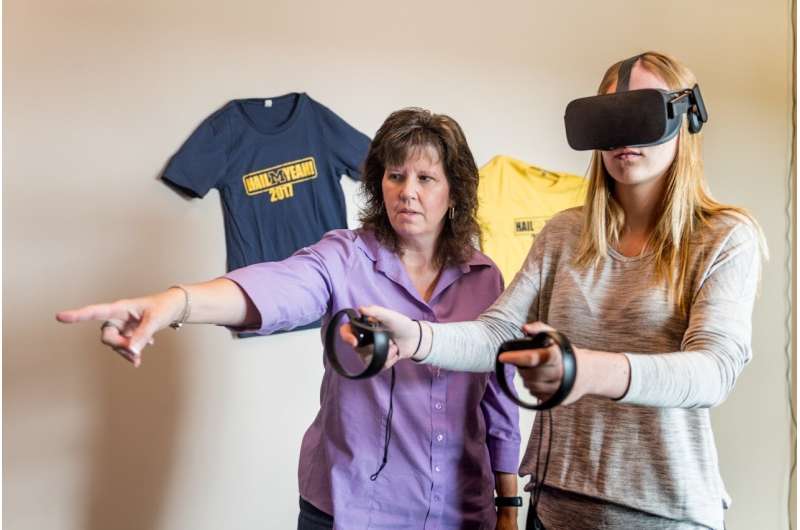
A team of faculty from the University of Michigan Center of Academic Innovation, School of Nursing and College of Pharmacy designed an innovative way to teach nursing and pharmacy students about the intricacies of chemotherapy.
Led by Michelle Aebersold, clinical professor of nursing, the group created Under the Skin, a virtual reality experience that guides students on handling high-risk complications when giving chemotherapy drugs to treat cancer.
Their goal is to show how to safely administer anti-cancer drugs, handle urgent situations and get students to deeply understand what is happening at the cellular level when giving treatments.
Chemotherapy is similar to poison; it destroys the cells if it leaks outside the blood vessel. Therefore, students must know how to deal with emergencies like a drug spilling on the floor or a patient having an allergic reaction. While using a virtual reality headset, they can learn to handle these situations in a safe simulation setting.
“We figured VR is a great way to represent that cellular level,” Aebersold said.
This simulation is tailored for practicing nurses and nursing students—once they get into their clinical rotations—and pharmacy students or pharmacists.
“Pharmacists mix up these drugs and are very involved with making sure that the antidotes we need to administer if the drug leaks into the skin exist,” Aebersold said.
The program complements the workshops the School of Nursing has provided for the past four years. Previously, students would learn about chemotherapy in these workshops and then practice with other nurses. But these workshops and experiences went virtual due to COVID-19.
The simulation, however, can improve the in-person practice. Once students put the VR headset on, they transition into a world simulating an actual treatment room where they can practice with an avatar representing the patient.
“When in the simulation, the participant experiences the patient complaining about a symptom and then tries to recognize the problem. Then, they take a magnifying glass and click a button to go under the skin and see what the cells look like. Once they come back out, they figure out how to treat the patient,” Aebersold said.
https://youtube.com/watch?v=EPZA0JIgVLY%3Fcolor%3Dwhite
As of now, the program is still in the testing phase. However, Aebersold has received feedback from students in the School of Education who did user testing. The final and current version was recently completed by the Center for Academic Innovation and delivered in September.
After learning all the project’s objectives, Moeezo Saleem created 2D storyboards with the help of user experience designers, then began prototyping.
“There was a lot of back and forth when creating the prototypes to make sure things looked right,” said Saleem, XR software developer at the Center for Academic Innovation. “This was a completely new thing that I hadn’t studied, so we had lots of communications with the team. Also, the nursing students would be learning through it, so we wanted to make sure everything was accurate.”
Eventually, the Academic Innovation team will place the program on a website to download the simulation and use it on a headset.
“One of the next steps would be to make the program available for faculty to use as part of a lab session or for cancer-focused elective classes,” Aebersold said.
Chloe Preble, a student in the XR certificate program at the School of Information, leads the final round of user testing for her master’s thesis.
“I think this is cool because it allows students to actually be a large part of our usability study,” Aebersold said. “As soon as it is approved, we will start recruiting nurses, nursing students, pharmacy students and pharmacists to use the program.”
Preble is getting her master’s as a user experience researcher. Last May, she became involved with the project and released flyers to recruit nurses and pharmacists to sign up for the pilot testing.
“I wanted to work with VR for my master’s and was accepted to work with Michelle (Aebersold),” she said. “The simulations are pretty amazing. They are well done and I think that they support students’ learning.”
Preble wants to evaluate the simulation’s usability and educational value. She plans to give participants using the simulation a before and after test—the System Usability Scale and the NASA TLX. This tool can quantify a subjective experience of workload.
Source: Read Full Article
